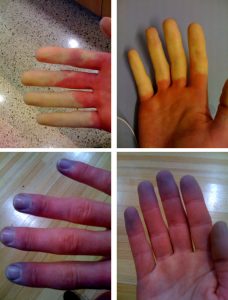All you need to know about Raynaud’s phenomenon: Cause, Symptoms, Diagnosis and Treatment
What is Raynaud’s phenomenon? It is the temporary interruption of circulation in the outer extremities, most commonly the fingers and toes. Attacks take only a few minutes. The blood supply is restored at last and the situation returns to normal. Raynaud’s phenomenon can occur in healthy people, but may also be a symptom of a rheumatic or vascular disease. The condition took it’s name from Doctor Gabriel Maurice Raynaud. This French doctor described this phenomenon for the first time in 1862.
What is the cause of the Raynaud’s phenomenon?
Medical science has not yet identified the cause of this disease. The symptoms may be caused by cold, emotions, tension, vibration or the use of certain medication. As a result, the small arteries contract for a short period of time. As a result, the blood supply to the small blood vessels of the extremities decreases, which are usually the fingers and toes. Such an attack only lasts a few minutes.
What are the symptoms of Raynaud’s phenomenon?
Another name for Raynaud’s phenomenon is the three-color phenomenon. At the beginning of the attack, a white discoloration of the toes or fingers occurs. This is because the contracting blood vessels supply insufficient blood to the skin. After this white phase the fingers or toes color purple. This is because the blood in the blood vessels does not flow well. The body responds to the blocked blood flow by creating substances that widen the blood vessels in the skin. This enhances the purple color to a dark purple color. During the first and second stages of Raynaud’s phenomenon, severe pain and tingling may occur. The fingers or toes feel dead. In the third and final phase, the blood flow of the limbs increases again. This causes the fingers or toes to warm up and color them red.
Temporary interruption of blood flow in other parts of the body may also occur. Such as the tip of the nose or ears. Due to the restricted blood flow the heart muscle gets a little less blood during the attack, which may also cause chest pain. Limited blood flow to the kidneys and lungs may also occur. In the first situation this affects blood pressure and in the second situation there may be shortness of breath. Smoking can elicit and strengthen the symptoms.
What is the difference between Raynaud’s primary and secondary phenomenon?
Raynaud’s disease is the primary condition, and it is common in healthy people. If discoloration of the fingers or toes may also be a symptom of a vascular or rheumatic disorder, then it is Raynaud’s secondary phenomenon. This phenomenon may occur in patients with scleroderma, mixed connective tissue disease (MCTD), Sjögren’s syndrome, lupus erythematosus (LE) and rheumatoid arthritis. The symptoms of this condition may also occur in arterial and vascular inflammation.
How do doctors diagnose Raynaud’s phenomenon?
The signs of Raynaud’s phenomenon are generally very clear. On the basis of patient complaints, a doctor can quickly make a diagnosis. Because this phenomenon fits some rheumatic and vascular diseases, it is usually not necessary to conduct a thorough investigation. However, the doctor will carefully review the medications the patient uses. For example, beta blockers may have a narrowing effect on blood vessels. Extensive research does usually take place in Raynaud’s primary phenomenon, i.e., in healthy people. The primary form affects as many as 20% of women of child bearing age. This is a mild form that disappears after a few years. When Raynaud’s phenomenon affects only one hand or foot, additional testing will be performed rule out abnormalities in the blood vessels.
How do doctors treat Raynaud’s phenomenon?
Learning to avoid situations that can trigger an attack is the most important part of the treatment.
The patient should avoid exposure to cold and aim for a warm and dry environment. Warm socks and gloves can help prevent attacks in the autumn and winter. Always wear a head cover when it’s cold outside. As much as 30% of the body heat disappears through the head. Emotions and tensions are more difficult to control.
The advice is to carefully check what conditions evoke Raynaud’s phenomenon. For example, a specific kind of movie or particular places, people or situations, this has to be avoided as soon as possible. Your doctor will advise that you quick smoking, if applicable, which causes blood vessel contraction. The doctor may also prescribe drugs that dilate the blood vessels. In severe cases, your doctor can administer an infusion of prostacyclin. This substance is active in the body for a short while. The treatment will therefore have to be given by continuous infusion. Therefore, this treatment is only given in emergency situations, for example when occlusion of toes or fingers is indicated.

Share this page
Tweet

Download for free the booklet ‘Moving without pain’ with a retail value of $6.75 / £4.95.
Any questions? Please feel free to contact us. Contact us.






